#4. normalizes LGBTQ+ diversity
Text
“baLduRs gAtE diDnT deServe tHe GoTY AwArd” I’ll bite you
#1. has 50-100 hours worth of gameplay#2. each dialogue has a unique reaction#3. has several different unique story modes that have individual stories for each playable companion#4. normalizes LGBTQ+ diversity#5. has a development team that readily listens to their players and on several occasions have added exactly what the players want#6. the story is fucking amazing#7. has been in development for YEARS including a several year window of early access where they got activefeedback from their players#includes Easter eggs of its predecessor (BG2) that launched more than 15 years ago#9. Promises no payable DLC or additions will be added so all players can enjoy the game to its full potential without having to pay extra#must I go on???
19 notes
·
View notes
Note
Yo, I've seen your book rec posts on and off for a while, and I was wondering if you could (if you have time ^.^ if not, that's cool too) throw up a list of your favorite lgbt/neurodivergent/unique protagonist books? I don't think I've ever read a book outside of fanfiction where the lead/s weren't just some form of 'normal' or straight or whatever. Also, since you're one of my favorite authors I feel like I'd be more inclined to give one of them a go lol ^.^'
There are an increasing number of diverse books out there!
Here are some of my personal favourites in no particular order, by which I mean I have rated them 4 stars (I really liked it) or 5 stars (it was amazing) and then curated the list some more on top of that. E.g. I might have thought it was amazing at the time, but if I can't tell you anything that happened in the story years after reading it, it's not on the list. That doesn't mean it's not worth reading, just that I have a bad memory so if I remember it definitely did something right!)
You can find more books I've read on my Goodreads. There are books that fit what you've asked for on there, it just doesn't fit my personal curated favourites list!
LGBTQ books
The Song of Achilles by Madeline Miller (m/m)
If We Were Villains by M.L Rio (m/m)
Girls Made of Snow and Glass and Girl, Serpent, Thorn by Melissa Bashardoust
Sawkill Girls by Claire Legrand (f/f + ace)
In the Dream House by Carmen Maria Machado (f/f - non fiction)
Salt Slow by Julia Armfield (f/f)
Giovanni's Room by James Baldwin (m/m)
Nightwood by Djuna Barnes (f/f - though be warned, this is a weird one! Rated highly more because I can't get it out of my head than that I liked it)
Tipping the Velvet and Fingersmith by Sarah Waters (f/f)
The Seven Husbands of Evelyn Hugo by Taylor Jenkins Reid
Peter Darling by Austin Chant (m/m, trans)
The Binding by Bridget Collins (m/m)
The House in the Cerulean Sea by T.J Klune (m/m)
Plain Bad Heroines by Emily M. Danforth (f/f)
The Greenhollow duology by Emily Tesh (m/m)
These Violent Delights by Micah Nemerever (m/m)
One Last Stop by Casey McQuiston (f/f)
(Obligatory read MY BOOK The God Key (m/m) here!) Obviously, this is my favourite ;)
Unique/Interesting protagonists:
Eleanor Oliphant is Completely Fine by Gail Honeyman
Sharp Objects by Gillian Flynn
The Amazing Adventures of Kavalier and Clay by Michael Chabon
I Am Not A Serial Killer by Dan Wells
Middlegame by Seanan McGuire (Her Wayward Children series is also great and has a lot of LGBTQ rep!)
The Kiss Quotient by Helen Hoang (MC has Asperger's)
A Spindle Splintered by Alix.E. Harrow (terminally ill MC, also f/f)
Fugitive Pieces by Anne Michaels
House of Leaves by Mark.Z. Danielewski
The Curious Incident of the Dog in the Night Time by Mark Haddon (Autistic MC)
Disfigured: On Fairytales, Disability and Making Space by Amanda Leduc (nonfiction)
#books#book rec#book recs#read#reading#book recommendation#boom recommendations#lit#literature#lesbian literature#gay literature#lgbtq books
226 notes
·
View notes
Text
WASHINGTON (AP) — Americans view college campuses as far friendlier to liberals than to conservatives when it comes to free speech, with adults across the political spectrum seeing less tolerance for those on the right, according to a new poll.
Overall, 47% of adults say liberals have “a lot” of freedom to express their views on college campuses, while just 20% said the same of conservatives, according to polling from the The Associated Press-NORC Center for Public Affairs Research and the University of Chicago Forum for Free Inquiry and Expression.
Republicans perceive a stronger bias on campuses against conservatives, but Democrats see a difference too — about 4 in 10 Democrats say liberals can speak their minds freely on campuses, while about 3 in 10 Democrats say conservatives can do so.
“If you’re a Republican or lean Republican, you’re unabashedly wrong, they shut you down,” said Rhonda Baker, 60, of Goldsboro, North Carolina, who voted for former President Donald Trump and has a son in college. “If they hold a rally, it’s: ‘The MAGA’s coming through.’ It’s: ‘The KKK is coming through.’”
Debates over First Amendment rights have occasionally flared on college campuses in recent years, with conflicts arising over guest speakers who express polarizing views, often from the political right.
Stanford University became a flashpoint this year when students shouted down a conservative judge who was invited to speak. More recently, a conservative Princeton University professor was drowned out while discussing free speech at Washington College, a small school in Maryland.
At the same time, Republican lawmakers in dozens of states have proposed bills aiming to limit public colleges from teaching topics considered divisive or liberal. Just 30% of Americans say states should be able to restrict what professors at state universities teach, the poll found, though support was higher among Republicans.
Overall, Republicans see a clear double standard on college campuses. Just 9% said conservatives can speak their minds, while 58% said liberals have that freedom, according to the polling. They were also slightly less likely than Americans overall to see campuses as respectful and inclusive places for conservatives.
Chris Gauvin, a Republican who has done construction work on campuses, believes conservative voices are stifled. While working at Yale University, he was once stopped by pro-LGBTQ+ activists who asked for his opinion, he said.
“They asked me how I felt, so I figured I’d tell them. I spoke in a normal tone, I didn’t get excited or upset,” said Gauvin, 58, of Manchester, Connecticut. “But it proceeded with 18 to 20 people who were suddenly very irritated and agitated. It just exploded.”
He took a lesson from the experience: “I learned to be very quiet there.”
Republicans in Congress have raised alarms, with a recent House report warning of “the long-standing and pervasive degradation of First Amendment rights” at U.S. colleges. Some in the GOP have called for federal legislation requiring colleges to protect free speech and punish those who infringe on others’ rights.
Nicholas Fleisher, who chairs an academic freedom committee for the American Association of University Professors, said public perception is skewed by the infrequent cases when protesters go too far.
“The reality is that there’s free speech for everyone on college campuses,” said Fleisher, a linguistics professor at the University of Wisconsin, Milwaukee. “In conversations within classrooms, people are free to speak their minds. And they do.”
Officials at PEN America, a free speech group, say most students welcome diverse views. But as the nation has become more politically divided, so have college campuses, said Kristen Shahverdian, senior manager for education at PEN.
“There’s this polarization that just continues to grow and build across our country, and colleges and universities are a part of that ecosystem,” she said.
Morgan Ashford, a Democrat in an online graduate program at Troy University in Alabama, said she thinks people can express themselves freely on campus regardless of politics or skin color. Still, she sees a lack of tolerance for the LGBTQ+ community in her Republican state where the governor has passed anti-LGBTQ legislation.
“I think there have to be guidelines” around hate speech, said Ashford. “Because some people can go overboard.”
When it comes to protesting speakers, most Americans say it should be peaceful. About 8 in 10 say it’s acceptable to engage in peaceful, non-disruptive protest at a campus event, while just 15% say it’s OK to prevent a speaker from communicating with the audience, the poll found.
“If they don’t like it, they can get up and walk out,” said Linda Woodward, 71, a Democrat in Hot Springs Village, Arkansas.
Mike Darlington, a real estate appraiser who votes Republican, said drowning out speakers violates the virtues of a free society.
“It seems to me a very, very selfish attitude that makes students think, ‘If you don’t think the way I do, then your thoughts are unacceptable,’” said Darlington, 58, of Chesterfield County, Virginia.
The protest at Stanford was one of six campus speeches across the U.S. that ended in significant disruption this year, with another 11 last year, according to a database by the Foundation for Individual Rights and Expression, a free speech group.
Those cases, while troubling, are one symptom of a broader problem, said Ilya Shapiro, a conservative legal scholar who was shouted down during a speech last year at the University of California’s law school. He says colleges have drifted away from the classic ideal of academia as a place for free inquiry.
An even bigger problem than speakers being disrupted by protesters is “students and faculty feeling that they can’t be open in their views. They can’t even discuss certain subjects,” said Shapiro, director of constitutional studies at the Manhattan Institute think tank.
About three in five Americans (62%) say that a major purpose of higher education is to support the free exchange and debate of different ideas and values. Even more U.S. adults say college’s main purpose is to teach students specific skills (82%), advance knowledge and ideas (78%) or teach students to be critical thinkers (76%). Also, 66% said a major purpose is to create a respectful and inclusive learning environment.
“I believe it should be solely to prepare you to enter the workforce,” said Gene VanZandt, 40, a Republican who works in shipbuilding in Hampton, Virginia. “I think our colleges have gone too far off the path of what their function was.”
The poll finds that majorities of Americans think students and professors, respectively, should not be allowed to express racist, sexist or anti-LGBTQ views on campus, with slightly more Republicans than Democrats saying those types of views should be allowed. There was slightly more tolerance for students expressing those views than for professors.
About 4 in 10 said students should be permitted to invite academic speakers accused of using offensive speech, with 55% saying they should not. There was a similar split when asked whether professors should be allowed to invite those speakers.
Darlington believes students and professors should be able to discuss controversial topics, but there are limits.
“Over-the-top, overtly racist, hateful stuff — no. You shouldn’t be allowed to do that freely,” he said.
___
The poll of 1,095 adults was conducted Sept. 7-11, 2023, using a sample drawn from NORC’s probability-based AmeriSpeak Panel, which is designed to be representative of the U.S. population. The margin of sampling error for all respondents is plus or minus 4 percentage points.
47 notes
·
View notes
Text
Andre Braugher's portrayal of Raymond Holt in the television series "Brooklyn Nine-Nine" has had a significant impact on both the queer and Black communities. Let's delve into an in-depth analysis:
**1. **Queer Representation:**
- **Complex and Nuanced:** Braugher's portrayal of Captain Holt is notable for its complexity. Holt is a high-ranking, openly gay police officer, challenging stereotypes about LGBTQ+ individuals. His character is not defined solely by his sexual orientation but rather by his intelligence, leadership skills, and dry sense of humor.
- **Normalization of LGBTQ+ Leadership:** Holt's position as the captain of the precinct serves to normalize LGBTQ+ individuals in positions of authority, contributing to the broader representation of diverse experiences within the queer community.
**2. **Impact on the Black Community:**
- **Breaking Stereotypes:** Captain Holt is a multi-dimensional character who breaks traditional stereotypes associated with Black individuals on television. His role as a high-ranking officer in a police precinct challenges preconceived notions and offers a positive representation of Black leadership.
- **Intersectionality:** Holt's character also explores the intersectionality of being Black and gay. This intersectional representation is crucial for acknowledging and celebrating the diversity within the Black community.
**3. **Subversion of Tropes:**
- **Avoidance of Stereotypical Tropes:** Andre Braugher, through his performance, ensures that Holt's character avoids falling into stereotypical portrayals of gay characters or Black characters often seen in mainstream media. This subversion contributes to a more authentic and well-rounded depiction.
**4. **Impact on Viewers:**
- **Inspiration and Empowerment:** Holt serves as an inspiration for individuals who identify with the intersection of being both queer and Black. Seeing a character like Holt in a position of authority can empower viewers who may have felt underrepresented or marginalized.
- **Normalizing Diverse Experiences:** The portrayal of Holt contributes to normalizing the diversity of experiences within the LGBTQ+ and Black communities. It sends a powerful message that individuals can be successful, respected, and influential regardless of their sexual orientation or race.
**5. **Social Commentary:**
- **Addressing Discrimination:** Throughout the series, Holt's character addresses instances of discrimination based on his identity. This provides an opportunity for the show to engage in social commentary, highlighting real-world issues of discrimination faced by both the queer and Black communities.
In conclusion, Andre Braugher's portrayal of Raymond Holt in "Brooklyn Nine-Nine" goes beyond just representation; it serves as a nuanced, empowering, and socially conscious character that positively impacts both the queer and Black communities. Holt's character is a testament to the importance of authentic and diverse storytelling in mainstream media.
#andre braugher#captain holt#captain raymond holt#raymond holt#brooklyn 99#b99#brooklyn nine nine#rip#rip andre braugher#chatgpt
18 notes
·
View notes
Text
Are Media Representations of Fans Fair? Experience of Fandom
#Week9 #MDA20009
Introduction
In a world where media dominates our lives, it's essential to reflect on how it portrays fans. Are the common depictions of fans as 'weird and 'overly emotional' fair, or are they merely stereotypes? In this blog post, we'll explore these stereotypes and discuss my own personal experience with fandom.

Section 1: Media Stereotypes of Fans
Media's Lens on Fandom
The media often portrays fans in a rather unflattering light. Think about TV shows where obsessive fans depicted as socially awkward or news sentimental that sensationalize fan reactions. These portrayals perpetuate stereotypes, making it seem like fandom is a realm of eccentricity (Fuschillo 2020).
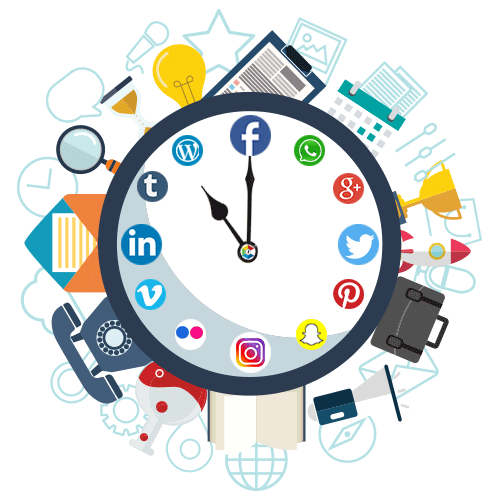
Examples of Stereotypes
Consider instances in movies and television where fans are caricatured as fanatics, and their passion is ridiculed. The classic portrayal of a fan living in their parents' basement, surrounded by merchandise, and socially isolated is a stereotype that has been perpetuated for decades. News reports during major fan events might focus solely on 'crazed' fans, ignoring the diverse and passionate community that these events bring together (Fiske 2017).
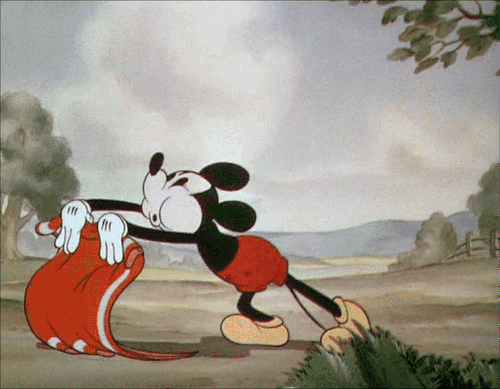
The Impact of Stereotypes
These media stereotypes can be damaging. they contribute toa misconception that fandom is something to be ashamed of or that fans are somehow less 'normal'. This misrepresentation can lead to stigmatization and exclusion, making it challenging for individuals to express their passion openly (Stewart et.al 2021).
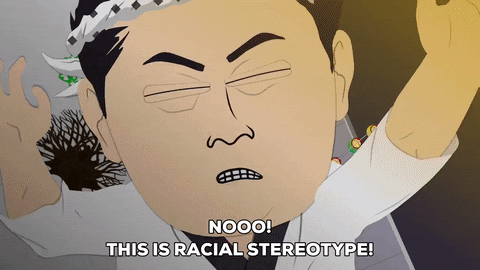
Section 2: Challenging the Stereotypes
Breaking the Mold
Thankfully, fans have been challenged these stereotypes, and they've been doing so in remarkable ways. They're actively disproving the misconception that the media perpetuates by showcasing their creativity, social activism, and positivity.

Fan Communities Making a Difference
One of the most powerful ways fans have challenged these stereotypes is by making a positive impact. For communities often 2come together for charitable causes. They organize fundraisers, donate to worthy charities, and use their shared love for a franchise or show to make a real-world difference. For example, "fandom charities" have raised millions of dollars for causes like disaster relief, children's hospitals, and environmental conservation (Mastromartino & Zhang 2020).
Campaigns organized by fans have also raised awareness for important causes. Whether it's advocating for social justice, raising awareness about a mental health issues, or supposedly LGBTQ+ rights, fan communities have been at the forefront of many meaningful campaigns. This leverage their passion and influence to bring about positive change.

Section 3: My Personal Fandom Experience
My Fandom Journey
My own journey as a fan has been nothing short of transformative. I fell in love with a particular show that resonates with me on a deep level. This show became more than just a form of entertainment, it was a source of inspiration, comfort, and a gateway to a whole new world of creativity.

Connections and Creative Expression
Being part of a fan community allowed me to connect with like-minded individuals who shared my passion. We discussed theories, analysed characters, and celebrated the show's milestone together. The sense of belonging within a community was a beautiful aspect of fandom.
Creativity played a significant role in my fandom experience. I started creating fan art, within fanfiction, and even participating in fan conventions. It was a way to express my love for the show and connect with others who felt the same way. The creative outlet that fandom provided was *incredibly fulfilling.
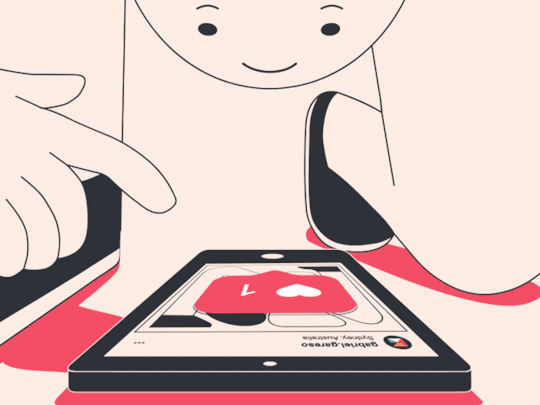
Section 4: The Diversity of Fandom
Fan Communities Are Diverse
One of the most significant misconceptions perpetuated by the media is the idea that fans are a monolithic group. In reality, fan communities are incredibly diverse. Fans come from all walks of life, and their passion can be a source of empowerment and identity.
Fandom is an inclusive space where people of different backgrounds, age, gender, and cultures come together over shared interests. This diversity adds depth and richness to fan communities, it's a place where you can find acceptance and understanding, ni matter who you are or where you come from (Cristofari & Guitton 2016).
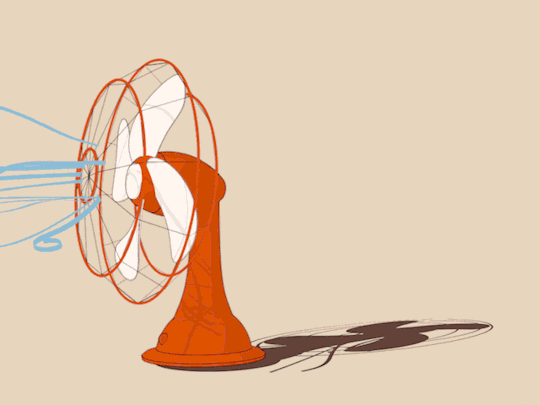
References
Cristofari, C & Guitton, MJ 2016, 'Aca-fans and fan communities: An operative framework', Journal of Consumer Culture, vol. 17, no. 3, viewed 7 November 2023, <https://journals.sagepub.com/doi/10.1177/1469540515623608>.
Fiske, ST 2017, 'Prejudices in cultural contexts: shared stereotypes (gender, age) versus variable stereotypes (race, ethnicity, religion)', Perspect Psychol Sci, vol. 12, no. 5, viewed 7 November 2023, <https://www.ncbi.nlm.nih.gov/pmc/articles/PMC5657003/>.
Fuschillo, G 2020, 'Fans, fandoms, or fanaticism?', Journal of Consumer Culture, vol. 20, no. 3, viewed 7 November 2023, <https://www.researchgate.net/publication/322273679_Fans_Fandoms_or_Fanaticism>.
Mastromartino, B & Zhang, JJ 2020, 'Affective outcomes of membership in a sport fan community', Frontiers in Psychology, 8 May, viewed 7 November 2023, <https://www.ncbi.nlm.nih.gov/pmc/articles/PMC7225319/>.
Stewart, R, Wright, B, Smith, L, Roberts, S & Russel, N 2021, 'Gendered stereotypes and norms: a systematic review of interventions designed to shift attitudes and behaviour', Heliyon, vol. 7, no. 4, viewed 7 November 2023, <https://www.ncbi.nlm.nih.gov/pmc/articles/PMC8066375/>.
2 notes
·
View notes
Text
FOGGY SAVE #8 | WILLOW CREEK
WELCOME TO WILLOW CREEK!
(I DID NOT CREATE ANY OF THE BUILDINGS SHOWN!)
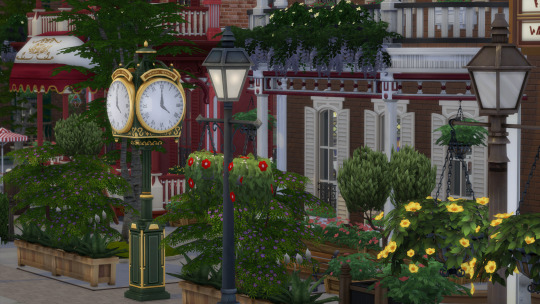


Nestled within a picturesque landscape of lakes, meandering rivers, and lush trees, Willow Creek exudes a captivating charm that envelops both residents and visitors alike. This idyllic town, with its enchanting natural beauty, offers a sanctuary of tranquility and respite from the bustling outside world.
The residents of Willow Creek are a diverse tapestry of individuals, each contributing their unique stories and perspectives to the town's vibrant fabric. From young families seeking a peaceful haven to retirees savoring the serenity of their golden years, Willow Creek welcomes people from all walks of life (we're going to ignore that i didn't make a single elder sim).
In contrast to its picturesque scenery, Willow Creek harbors an undercurrent of judgment and toxic social dynamics. The town's obsession with conformity and upholding traditional values often creates an oppressive environment for those who do not fit the narrow definition of "normal."
The residents of Willow Creek, while outwardly pleasant, are often quick to pass judgment and hold strict expectations for their neighbors. Deviation from societal norms is met with skepticism and disdain, leading to a pervasive atmosphere of conformity and a fear of being labeled an outsider.
In this close-knit community, there is an intense pressure to conform to societal standards, both in appearance and behavior. The pursuit of material wealth, social status, and the appearance of a picture-perfect life are deeply ingrained in the town's culture. This emphasis on maintaining appearances often leads to shallow relationships and a lack of genuine connections among residents.
The town's obsession with tradition also stifles progress and hinders acceptance of diversity. Alternative lifestyles, non-conforming identities, and differing beliefs are often met with hostility, further perpetuating a culture of exclusion and intolerance. But that's the stuff they won't tell you on tv ;)
As far as the public knows (and ever will know), Willow Creek is the ideal place to be!

FINALLY FINISHED WITH ALL OF THE WILLOW CREEK RESIDENTS!
In all honesty it ended with the potters but I tend to post my sims after I finish everyones everyday outfit. Still have to finish their outfits, give them likes and dislikes, a job/afterschool acivity, skills, lgbtq preferences, etc. My save's are always VERY detailed and personalized, it takes me forever to finish one world. Last time it took me 4 months to finish Willow Creek so glad it only took me one month this time 😭
Next up is Oasis Springs! I tend to fight with myself on whether to make Oasis Springs a very nice looking Spanish town or a very poor, beaten up and broken American town. In all honesty I think i'm gonna mix it up this time and do both.
4 notes
·
View notes
Text
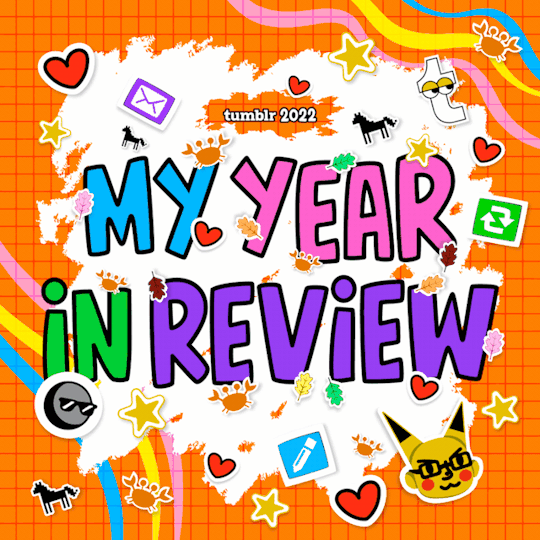
I posted 1,221 times in 2022
That's 141 more posts than 2021!
165 posts created (14%)
1,056 posts reblogged (86%)
Blogs I reblogged the most:
@salemruinseverything
@combeauferre
@sithiegoodness
@castielsupernatural
@twelvefifteencomic
I tagged 1,193 of my posts in 2022
Only 2% of my posts had no tags
#i like (the idea of) queue - 567 posts
#bastille - 127 posts
#send my regards to super hell - 110 posts
#video - 81 posts
#spn - 58 posts
#tiktok - 53 posts
#jill gets asks - 47 posts
#writing shit - 44 posts
#charlie barnes - 36 posts
#destiel - 35 posts
Longest Tag: 138 characters
#so when it went back to paper for a bit i’d just take entire plates of fruit and dessert with me when i left 🤷♀️ sometimes real food too
My Top Posts in 2022:
#5
yes i’m totally normal about woody & his dad doing a lil pub gig with dan and charlie and proceeding to play teenage dirtbag together, during which dan comes up to the mic with his phone open to the lyrics and then proceeds to immediately leave his microphone and go share with charlie instead for literally no reason. i’m fine <3 just . look at this shit
53 notes - Posted April 17, 2022
#4

ok but i am CRYING at this headline
57 notes - Posted January 6, 2022
#3
this was too long for twitter but honestly i was pleasantly surprised about the publicity for heartstopper because i expected everyone on twitter to be like "wELL if every single actor doesn't immediately come out to everyone then how do we KNOW all the queer characters are actually being played by queer actors hmMM??" bc yknow. the internet is just Like That 🙃
and heartstopper's response (bc they almost certainly anticipated this) was literally just like "we have a queer cast, trust us, and not a single person in the cast owes you any more information than that. not to MENTION we go above and beyond to show you that this tv series was CREATED not only by an openly queer author who was given FULL control to write the entire screen adaptation of their own graphic novels, but also by a openly queer director who specifically made sure to hire as many queer workers as possible for every. other. department of the show. because yes, it's super important that queer actors play queer characters; but it's even MORE important that the representation extends FAR beyond the people you see on screen."
bc THAT IS HOW YOU HAVE GOOD REPRESENTATION. NOT forcing all of your actors to spend every single interview fielding questions about their own personal gender & sexual identities. good representation is making sure that―unlike the majority of films and tv shows, sadly―if you look beyond the main cast, the roles of director/producer/writer/photographer/makeup artist/crew member/etc are ACTUALLY fulfilled by a diverse group of talented people. true representation doesn't stop at the actors, or the portrayal of characters. it goes all the way up the ladder to everyone making the movie/tv show/etc happen in the first place. change can't happen long-term unless "older," well-established people in the industry (like euros lyn) use their position to create opportunities for fresh, new, young, diverse talent.
tldr heartstopper is a brilliant example of how to properly create a series both by and for the lgbtq+ community, and i was SO relieved to see all the publicity revolve around the story and the actors and the importance of representation WITHOUT requiring anybody who wasn't already out to clarify anything about themselves.
(ramble mostly inspired by this and sourced from this, if you haven't watched the video you 100% should !!! also ofc special shoutout to kit for taking absolutely no shit from twitter)
70 notes - Posted May 16, 2022
#2
me, busy screaming about bim & senab maybe going on the US tour with bas
meanwhile, bastille:
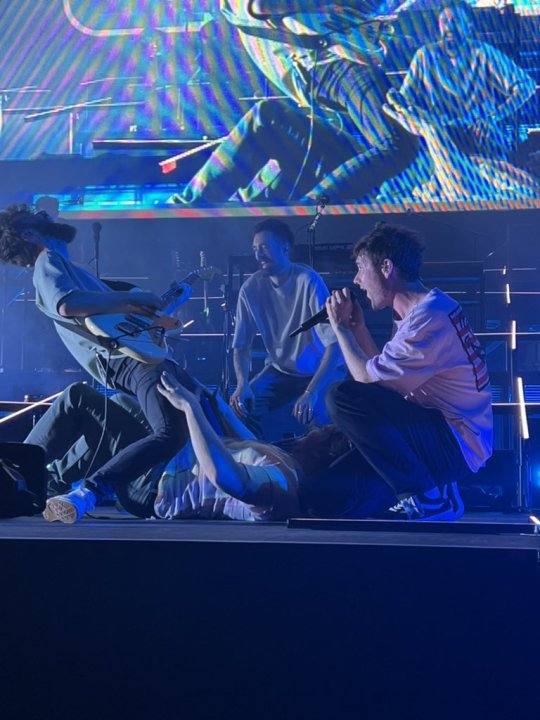
85 notes - Posted April 18, 2022
My #1 post of 2022
ok slight tour spoiler ahead but: during one segment he asked us to pick a noise and an influencer. someone said ‘boink’ and he was like ‘somehow that still sounds sexual’ and then we got to influencer and he was like ‘oh my god did someone say PHIL??’ so the sentence ended up being something about a secret society called the boink run by phil lester
and THEN he fucking says (something like) ‘joke’s on you, me and phil have been in boink together from the START!!!’ and. dan. my dude. YOU were the one who said boink sounded sexual do you not realize what that Sounds Like 💀
172 notes - Posted October 14, 2022
Get your Tumblr 2022 Year in Review →
4 notes
·
View notes
Text
Behind the Umbrellas: Marginality as Joyful Resistance
Final Queer Video
When we first talked about the video project, I thought of Parasol Patrol, a non-profit founded by Eli Bazan and Pasha Ripley in 2019. I wanted to show how Parasol Patrol creates a queer space in the midst of a visual culture filled with hate and violence aimed at LGBTQ children. The Barker and Scheele (2016) graphic novel informed my goals.
1. I wanted to show one type of queer activism (p. 51). As queer people of color, Eli and Pasha are uniquely able to address the threats facing queer children, including queer children of color.
2. Barker and Scheele describe “how queer theory has engaged with popular culture…” (p. 6) and given the increasingly violent actions directed at trans people and at drag events, I wanted to show how a local organization could resist the hate targeting LGBTQ folx.
3. Barker and Scheele say, “Queer activism is a form of sexuality/gender activism that opposes assimilationist agendas of trying to show how ‘normal’ LG(BT) people are. Instead it celebrates difference and diversity…” (p. 15). Pasha often says, “We’re here because of the hate groups. We’re not here for them.” Parasol Patrol carves out a space in the midst of violent hate that doesn’t try to change LGBTQIA children—it celebrates them. I wanted to show this joy.
4. Most importantly, I wanted to make queer media about queer people. So I focused on how Parasol Patrol creates space for youth to grow into powerful adults. Parasol is really about queer elders modeling community care for queer youth. This is our genealogy and I want to document it.
5. As a secondary goal, I wanted to create something Parasol Patrol can potentially use in its marketing because yay capitalism and the Nonprofit Industrial Complex.
I had good access to Eli, Pasha, and the rest of the Parasol Patrol regulars. I’ve been a Patroller since their 3rd month, so I knew getting footage and photos wouldn’t be a problem. I also felt pretty sure I could show the change in atmosphere when participants move from the hate group side of the venue to the protected queer-friendly side behind the umbrellas. I questioned how much of the hate I should show, and I’m still not sure I balanced that right.
I had some other problems. I’ve never made a movie, so in terms of technology, I started at zero. Mia provided some helpful guidance, and the links on the module helped with editing. I also tend to be pretty wordy (ha!) so my first proposal was enormous. I needed to cut the scope down.
I had some tech issues, all user error, but I finally got a first rough draft posted. Moss watched it before I submitted it to Canvas. Their feedback basically boiled down to “what does Parasol Patrol even do?” but said in a very nice way. I reworked the intro, but after submitting the 2nd version, I still needed to clarify some things, rethink some quotes, and work on my ever-lagging tech skills (note to self: film in landscape next time). This is when I added voice over, bullying my husband into being the narrator. He agreed because he’s scared of me I think.
Unique helped me figure out how to script something that made sense without having to redo the whole video. She answered tech questions. She also gave me snacks and tea, both of which gave me enough energy to work on the video when the cold hit.
I sent the 3rd draft to Mia, she gave more feedback, and I changed roughly 1/3 of the video. I also added some different images about recent events.
While the assignment was for a 5 minute video, mine goes over that. The credits begin at 5 minutes 25 seconds, so that’s where the for-a-grade project ends. But. Because I wanted Parasol to be able to use the video, and because I adore the owner of Second Star to the Right Bookstore (she always gives us food when we patrol there), I added a Marvel-Studios style post credit clip. Honestly, in my eyes, Eli and Pasha and the rest of the patrollers are superheroes, and Dea has been a long-time knowledge-keeper and child-protector, so it seems very apropos.
Bryn
youtube
#queermedia#queer media#lgbtq#youtube#queermediastudies#queer media studies#final video#ParasolPatrol#disarmhate#activism#drag queen#drag queen story time#all ages drag
2 notes
·
View notes
Text
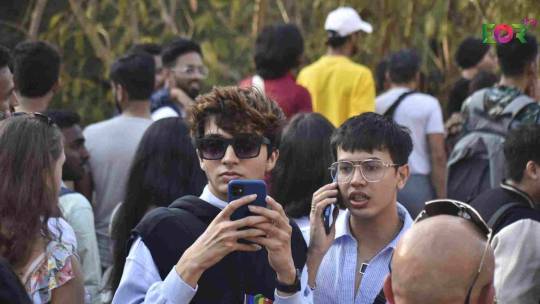
Challenging Stereotypes: How EORTV's Online Web Series Redefines LGBTQ Love and Representation
Introduction:
The influence of media on society's perception of the LGBTQ community is undeniable. However, EORTV, a rising online web series platform, is making remarkable strides in challenging limited and stereotypical portrayals. Through accurate and diverse representations of LGBTQ individuals and relationships, EORTV is redefining the landscape of LGBTQ love. Let's explore some of the ways EORTV's online web series watch free is actively challenging these stereotypes.
1. Embracing Relationship Diversity:
EORTV breaks free from the confinement of stereotypes by showcasing a wide array of relationships. It presents LGBTQ love as more than just flamboyant gay men or hyper-masculine lesbians, encompassing long-term partnerships, casual dating, and everything in between. By acknowledging this variety, EORTV's online web series demonstrates that LGBTQ relationships can parallel the range of experiences found in heterosexual dynamics.
2. Multi-Dimensional LGBTQ Characters:
In mainstream media, LGBTQ individuals are often reduced to their sexual orientation or gender identity, overshadowing their complexity. However, EORTV's watch online web series website presents LGBTQ characters as multi-dimensional, with diverse interests, passions, and flaws. By humanizing them beyond their LGBTQ identities, EORTV challenges the misconception that being LGBTQ solely defines one's character.
3. Normalizing LGBTQ Relationships:
EORTV's online web series' most powerful contribution lies in normalizing LGBTQ relationships. Contrary to mainstream portrayals that label them as deviant or abnormal, EORTV portrays LGBTQ relationships as ordinary, valid, and equally capable of profound love and compassion. This normalization undermines the stereotype that LGBTQ relationships are somehow lesser or unworthy of societal acceptance.
4. Addressing LGBTQ Issues:
EORTV's online web series fearlessly tackles issues specific to the LGBTQ community in India. By shedding light on topics like coming out, discrimination, and hate crimes, EORTV educates viewers and challenges prevailing stereotypes. This approach fosters empathy, understanding, and humanizes LGBTQ individuals in the eyes of the audience.
5. Representing Diversity:
EORTV's online web series proudly represents the true diversity within the LGBTQ community. Through its inclusion of characters with different racial and ethnic backgrounds, gender identities, and sexual orientations, EORTV dispels the notion of a monolithic LGBTQ experience. By challenging this stereotype, EORTV embraces the rich tapestry of the LGBTQ community and fosters understanding and acceptance.
Conclusion:
EORTV's groundbreaking efforts through its web series watch online to challenge stereotypes of LGBTQ love, featuring relationship diversity, multi-dimensional characters, normalization, addressing LGBTQ issues, and representing diversity, are transforming societal perceptions. By continuing to challenge stereotypes and celebrate the LGBTQ community's rich diversity, EORTV's online web series serves as a catalyst for positive change, ultimately reshaping how love and relationships are viewed in the online media landscape.
Link:- https://bit.ly/3JsgQUK
0 notes
Text
Main Streets Part 1
A main street is the a street central to a town with mixed use development, local businesses, and historic character. Here are some examples of main streets in our hometowns.
Hamilton, Ohio
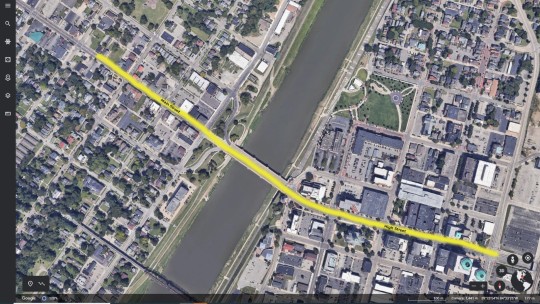
Hamilton, Ohio has a great example of a small-city main street made up of a long stretch which has been separated into two streets; Main Street and High Street. The portion of these streets which reflects a traditional main street starts at Main and E Street and runs south-east to High Street and MLK Jr. Boulevard. Despite being separated by the Great Miami River, these two streets flow together effortlessly and allow pedestrians to move from one side to the other with ease.


Main Street (top) and High Street (bottom) store fronts.
Both sides of the street are home to a variety of small-owned businesses. These local commodities, which range in terms of functions/services, mostly reside in a single-story storefront with multi-unit housing above it. This helps to create a vibrant feel along the main street example during any normal day with people coming to and from the shops/their residences in the area. It is also extremely close in proximity to one of the city’s most popular public parks which also houses a large apartment complex within walking distance of almost all the local businesses within Hamilton. The walkability of this area is most definitely high-scoring.
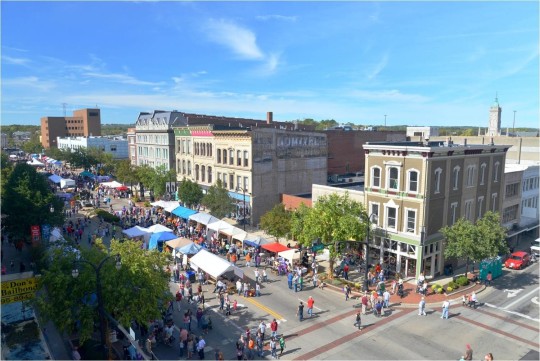
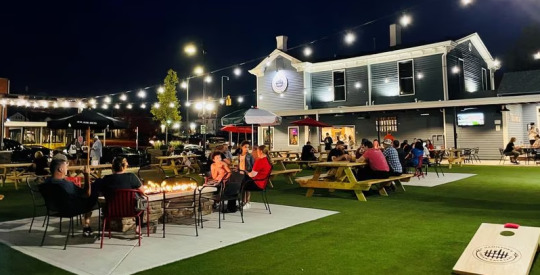
The weekly farmers market on High Street (top) and Hamilton’s Urban Backyard on Main Street (bottom) both play key roles in the streets’ success in terms of social life.
Main and High Street are both used as gathering points for many public events within the city. Small-business Saturday, a city-wide favorite event, brings an inflow of people onto Main Street and Pumpkin Fest floods High Street each year. More frequent events such as farmers and flea markets are often held in the High Street area on weekends while Main Street is home to Hamilton’s Urban Backyard, a public area connected to a brewery which features a multitude of local food trucks throughout the week. The diversity in uses really brings the community together in a variety of ways.
Lakewood, Ohio
Detroit Avenue in Lakewood, Ohio, a bordering neighborhood of Cleveland, is an excellent example of a successful Main Street for drivers, pedestrians, small business, and housing.
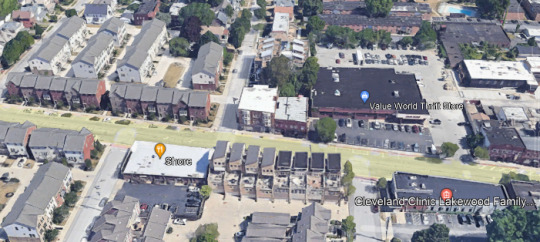
Detroit’s commercial district is its main attraction to locals in Lakewood. It features local and minority-owned businesses like Nosotros and Szechwan Garden, along with plentiful restaurants and a large grocery store. Detroit Avenue is also home to two elementary schools and many religious and cultural organizations, including an LGBTQ+ resource center. Sidewalks are wide and shaded, with plentiful tree coverage and outdoor, moveable seating. Along with its commercial and cultural abundance, plenty of dense housing can be found along Detroit. Apartment buildings varying in size, historic duplexes, and several multi-unit housing complexes can be found across the entire main street.

With the recent addition of a bike lane in both directions, between the four vehicular lanes, cyclists now have easy access to other main roads in Lakewood because of their connection to Detroit Avenue. The speed limit for cars was reduced from 35 to 25 mph, and it has become a very safe street despite the amount of traffic it collects per day. At most intersections of Detroit and other large streets (Bunts, for example), 4-way crosswalks for pedestrians are available.
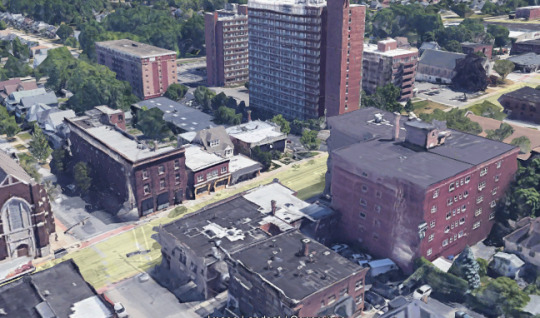
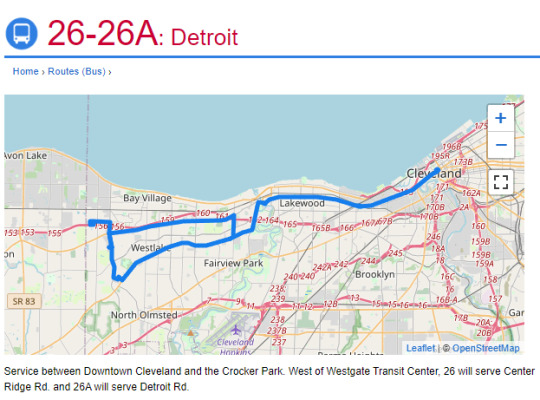
Along with cyclist and pedestrian usability, the 26-26A RTA bus route is one of the most used routes between Cleveland and Lakewood. It runs along Detroit Avenue, through Crocker Park, and to Downtown Cleveland.
0 notes
Text
LGBTQ+ representation in Doom Patrol
Doom Patrol is a superhero series created by Jeremy Carver that is currently broadcast on HBO Max and is based on DC comics of the same title. The pilot aired on 15th February 2019 and the ongoing fourth season was announced to be the last one as the series was canceled.
The main storyline follows a group of characters Larry Trainor, Rita Farr, Vic Stone “Cyborg”, Jane, and Cliff Steel who, as a result of traumatic events, received superpowers and, in some cases, immortality. However, most of the protagonists, except for Vic, consider themselves not superheroes but outcasts, and therefore they do not want to save people or the world, instead facing their own problems. Things change when one of the secondary characters Chief who kept them safe and protected for years, is kidnapped by the series' antagonist Mr. Nobody.
As for the structure, the first season of Doom Patrol consists of fifteen episodes and contains elements of serial and episodic storytelling with both kernels and satellites. The former focus on Mr. Nobody and the threat he poses and the latter explores various topics important to the main characters such as trauma, family, and sexuality which are crucial to the message of the whole series.
Doom Patrol sends a positive message about being part of the LGBTQ+ community, encourages embracing one’s sexuality, but also reminds of homophobia experienced for many generations and how diverse non-heteronormative people are.
Doom Patrol encourages embracing one’s sexuality. According to research conducted in 2018, tv series on streaming platforms are more open to LGBTQ+ themes and storylines [1] and the production is a good example of it. In episode eight of the season, titled “Danny Patrol” two main characters Vic and Larry visit Danny the Street – “the sentient teleporting gender queer street”[2] that is a safe space for everyone who has been excluded by society for some reason. In the above scene, Larry who entered one bar on the street imagines that he sings with everyone the song “People like us” by Kelly Clarkson. It is worth mentioning that in the first episode of the series, it is already stated that Larry identifies as gay, his orientation is a large part of his storyline, and in the comic books that are partially adapted by the series, he was the first character rewritten as the member of LGBTQ+ community in 1989[3], so it is important that he sings the song and not Vic whose sexual orientation was not defined in the first season. In addition to that, when Larry “gives” his performance in the club, a drag queen, Maura Lee Karupt, joins him on the stage as well as the rest of the audience. People of different genders and ethnicities are dancing and singing, dressed in various ways. In such a manner, the scene shows how the community of people who for some reason cannot find their place in “normal” society, can be diverse and colorful which is significant for the representation as most tv series mainly introduce white gay men as their protagonists. [4]
Moreover, The aesthetics of the scene itself is very lively, and colorful and some of the characters wear extravagant costumes. Everything seems to be good, and everyone seems to be happy and full of life. People here are different and everyone accepts them as they are.
Furthermore, The lyrics are also very important for this analysis as Larry sings:
“They can't do nothing to you, they can't do nothing to me
This is the life that we choose, this is the life that we bleed
So throw your fists in the air
Come out, come out if you dare
Tonight we're gonna change forever”
These words, sung by a group of diversified characters who more likely had experience prejudice before they lived at Danny the Street, make the series show that there is nothing wrong with being different and one’s identity should not be hidden but embraced.

Doom Patrol throughout many episodes shows the viewer how diverse non-heteronormative people are. The previously presented video clip presented characters belonging to the LGBTQ+ community as diverse, colorful, and full of energy. On the contrary, episode eleven “Frances Patrol” focuses on Larry and his old lover John Bowers. Despite Larry’s immortality, they are both of a similar age and had a relationship before Larry's accident after which they parted their ways. However, in the mentioned above episodes, Larry finally visits the elderly John and reconciles with him soon before his death. The scene shown in the photo presents the moment when together, after their serious conversation, they look at the together sunset for the last time.
The representation of elderly LGBTQ+ people in media is still insufficient and according to Malcolm Sargeant “There is some evidence that elder LGBT people suffer from discrimination within the community. The ‘‘gay scene’’ is said to be youth orientated. The elder members of the LGBT community who participated in research was that the pervasive story amongst older gay men is that visible signs of ageing can mark one as undesirable or unwelcome in gay culture”[5]. The series showing two older gay men spending the last moment of one of them argues that LGBT representation should not only include young people. The scene itself is very peaceful and the camera shot leaves the viewer as a distant observer of this intimate scene. In addition to that, the colors are warm, and the sunset can be associated with typical scenes from romantic films, which are mostly focused on heteronormative relationships. This scene can be seen as romantic and calm, which is a great opposite to the previous scene with a song. The series shows the different needs of LGBTQ+ community members of different ages. On the one hand, Doom Patrol shows young non-heteronormative people with their own ideas and beliefs, but on the other hand, it remembers older generations and presents different ways to express yourself, and validates both of them.
0 notes
Text
Aspen's interviews
Interview 1 - My first interviewee is a nursing student in the UF Nursing School at the hospital, Shands. She identifies as cisgender and bisexual. We found common ground in the fact that we are both looking towards a future in healthcare. When discussing some of her experiences at UF, she had stated that overall she had never really experienced any issues regarding her sexuality at the school. She did admit that overall there were places she did not advertise her bisexuality, such as in the workplace or in certain bars and clubs. However, she did state that she generally had not received a lot of biphobia because she generally surrounded herself with people of similar backgrounds or people who wanted to go into healthcare who felt they should be accepting of patients, regardless of background. We discussed UC and how it was a very comfortable environment to go to when going out with friends that was incredibly non-judgmental. She says most, if not all, of her classes are completely "chill" and "content focused." She says most of her fellow classmates are very accepting and nobody has been outwardly homophobic or intolerant of her sexuality.
Interview 2 - My next interviewee was part of the same pre-health organization I am in which is my pre-med fraternity. He is a gay man and also cisgender. We discussed many of the stigmas surrounding being gay and also being involved in medicine as most of the physicians and PAs are straight and cisgender. This is a demographic neither of us fit. He said he doesn't normally avoid most clubs and areas at UF and has felt incredibly accepted in the organizations he is in which are primarily pre-health focused. This was my experience as well, and I was interested to hear it had translated. He is a CNA, or Certified Nursing Assistant, outside of schooling. He admitted that when it comes to general healthcare at the hospital, many physicians are not incredibly well versed in LGBTQ+ healthcare and if he has a choice, he usually tries to find physicians who are okay with his sexuality as it makes him feel more comfortable. From personal experience, I had also struggled to find a physician who was transgender friendly. When I did, his waitlist was 6+ months because most people had wanted to see him for their healthcare as he was culturally competent. We discussed how as physicians it should be a pre-requisite to be culturally competent but because it is not, many medical professionals aren't. This can be alienating for patients. However, he said the majority of the people in our fraternity are overwhelmingly accepting and he has never felt ostracized for being gay. He does admit that because the fraternity prides itself on equity and diversity, that many people are queer themselves and this helps lessen the internal pressures and external pressures of being a gay man in a pre-medical setting.
Interview 3 - My third interviewee is a volunteer at UF Health Shands just like I am and she is a cisgender pansexual woman. She is also a student here at The University of Florida. At the hospital, I volunteer in the Pediatric ICU and the Pediatric Cardiac ICU. These wards are also known as 10-2 and 10-4. She also volunteers on these floors, however, she is not on the same shift as me so coordinating the interview had to be done outside of hospital shift times. She stated that overall, places she doesn't feel comfortable sharing her sexuality are at sorority or fraternity parties or bars across from the university at midtown. She says she has never been to UC, or the club University Club which is a predominantly queer club, however she has always wanted to go. She tells me in volunteering at the hospital she has always felt accepted through Child Life. The nurses, she claims, have always been kind to her when this has come up in conversation. She did admit to me, however, that this was not something that came up in conversation often as she does not have the stereotypical "queer" look. She also admitted she tends to keep it secret from strangers and internalizes it until she actually gets to know somebody well enough to conclude they are a safe space to go to to confide in. However, she says working with people who are also students like her, everybody has been very accepting. She has also made a few friends through volunteering who are also part of the LGBTQIA+ community. Overall, in pre-health spaces and healthcare spaces at UF, she has not really experienced intolerance or homophobia and she stated she is really grateful for this as it was one of her biggest worries before coming to college.
0 notes
Text
20+ Books That You (Might Actually Want) To Read During Pride Month!
Right, so. I got annoyed after seeing the list referenced in this post last night, told myself that my books are all packed up so I couldn’t do anything about it, and lasted all of a whopping 10 minutes before picking up my phone and attempting to make my own list instead. Behold, my from-memory attempt to present 20 books with strong LGBTQ plots, characters, and/or authors, that DON’T just rely on Suffering and Identity Politics and are... you know... fun.
Listed in alphabetical order by title. Links take you to Bookshop.org, where you can buy them from your local independent bookstore at a discount and NOT from the evil empire.
1. A Master of Djinn – P. Djeli Clark
* author of color
* steampunk Cairo in 1912
* djinn! magic! murder mystery!
* butch Arab lesbian main character
* devout hijabi Muslim badass assistant
* anticolonial alternate history
2. An Accident of Stars – Foz Meadows (Sequel: A Tyranny of Queens)
* trans author
* bi, pan, trans, aro representation
* racially diverse characters
* all female POV characters
* high-fantasy world adventures
3. Boyfriend Material – Alexis Hall
* queer author
* look I love this book SO MUCH and have absolutely screamed about it before but also I LOVE IT SO MUCH
* contemporary M/M fake dating in modern London, complete with full cast of disaster found-family queer friends
* it is. fucking. HILARIOUS. I almost died the first time reading it
* there is a sequel called HUSBAND MATERIAL scheduled to be released in 2022; I am a normal amount of excited for this book
4. Gideon the Ninth – Tamsyn Muir (Sequel: Harrow the Ninth)
* the book cover says “Lesbian necromancers explore a haunted palace in space!”
* that is exactly what you get
* slow-burn enemies-to-lovers F/F main romance
* I cannot describe this book, it is dark, genre-bendy, science fiction-y, Hunger-Games-with-lesbian-necromancers-in space? Kinda? I have literally never read anything like it
* also fucking HILARIOUS
5. One Last Stop – Casey McQuiston
* queer author (who wrote Red White and Royal Blue)
* bisexual fat girl from the South/lesbian-daughter-of-Chinese immigrants from the 1970s-riot-grrl main romance
* time traveling mystery involving the Q train in Brooklyn (mentions Brighton Beach ahem)
* magical realism
* many more found-family chaotic queers including a trans Latino psychic and a Black accountant by day/drag queen by night and the mean little gay disaster who has a hopeless crush on them
6. Parasol Protectorate (series) – Gail Carriger
* this is one of my favorite series, and there are five books: Soulless, Changeless, Blameless, Heartless, and Timeless
* steampunk vampires/werewolves late Victorian London, like Jane Austen crossed with P.G. Wodehouse (they are all fucking hilarious)
* pretty much everyone is queer; we got your flamboyantly camp gay vampires (Lord Akeldama ftw!) We got your gay werewolves! We got your lesbian French inventors! We got your big disaster idiot werewolf main male love interest! We got your crazy adventures! You name it we got it!
* two spin-off novellas: Romancing the Werewolf (M/M) and Romancing the Inventor (F/F)
* she has a ton more books in this same universe and writes sexy queer supernatural romance as G.L. Carriger
7. Plain Bad Heroines – Emily M. Danforth
* queer author
* historical horror-comedy set between a haunted girls’ school in early-1900s New England and in the modern day
* all sapphic female main characters
* plays with style/form/voice, a story within a story within a story
8. Red White and Royal Blue – Casey McQuiston
* you’ve probably heard of it but here I am reccing it again
* the biracial son of the first female POTUS falls in love with the Prince of England; shenanigans absolutely ensue
* yes, the British monarchy still absolutely sucks a big fat dick
* hilarious, heartfelt, reads like fanfic, just go get it, it will change your life
9. Rosaline Palmer Takes The Cake – Alexis Hall
* same author as Boyfriend Material, this is his newest
* bisexual female protagonist
* absolutely perfect satire of The Great British Bake Off (you can tell this man has watched EVERY SINGLE SERIES and all of the holiday specials)
* sweet and surprisingly thoughtful
10. Starless – Jacqueline Carey
* genderqueer/transmasculine main character of color
* almost all main characters are brown people!
* lush Middle Eastern/India-inspired fantasy world
* gods, prophecies, monsters
* the best Oh God Why Me I Am A Horrible Mentor wise-old-mentor
11. The Future of Another Timeline – Annalee Newitz
* nonbinary (they/them) author
* time travel but make it The Handmaid’s Tale
* will probably make your head explode
* feminist, queer, subversive
* diverse characters
12. The Gentleman's Guide to Vice and Virtue – Mackenzi Lee
* queer author
* technically YA but historical/magical adventure set in the 1700s
* bisexual disaster main protagonist and love interest of color
* (mis)adventures across Europe
* has a sequel (see below) with the badass asexual sister of the protagonist
13. The Hate Project – Kris Ripper
* nonbinary/genderqueer author
* M/M enemies to lovers/sex with no strings attached (spoiler alert: strings attached)
* HECKING HILARIOUS
* sweet, escapist, and very low stakes
* diverse characters, including fat protagonist with realistic anxiety disorder
14. The Lady's Guide to Petticoats and Piracy – Mackenzi Lee
* PIRATES, obviously
* sequel to Gentleman’s Guide
* asexual female protagonist
* strong queerplatonic f/f friendship
* more historical/magical 18th century adventures
15. The Last Rune (series) – Mark Anthony
* Imma be real with you chief, I haven’t read this series since I was a clueless teenager with no idea why I liked Gay Stuff so much, so if it does turn out to suck now, don’t throw rotten veggies at me
* but especially since it was written in the NINETIES, this series was hella progressive?!
* gay characters, disabled characters, characters of color, all playing significant and heroic roles in six-book epic fantasy cycle
* people from Earth end up in high-fantasy world of Eldh
* endgame M/M romance for the main character
* books out of print, I think, but you can find them cheap somewhere like AbeBooks; first one (Beyond the Pale) linked above
16. The Library of the Unwritten – A.J. Hackwith
* queer author
* heaven-hell-Valhalla supernatural adventures
* The Good Place x Good Omens x Lucifer x The Librarians
* Pansexual Black badass female heroine
* Queer found families
* The Sassiest TM Bisexual Villain Turned Reluctant Hero (is he my favorite? Why on earth would you think that.)
17. The Priory of the Orange Tree – Samantha Shannon
* epic doorstopper science fiction/historical fantasy set in a vaguely 16th-century world
* main F/F romance between a queen and her sorceress bodyguard
* sassy old gay alchemist whose backstory will give you Feelings
* so many strong women and characters of color
* no homophobia! marriage is fully gender-neutral, spouses are called “companions”
18. The Song of Achilles – Madeline Miller
* likewise one you have probably heard of but still
* a little light on the myth/historical part imho, but the writing is beautiful and will give you many feelings
* M/M romance between Achilles and Patroclus
* reimagining of The Iliad (her other book Circe is also really good)
19 The Stars are Legion – Kameron Hurley
* all-female apocalyptic space opera
* messy messy antiheroines
* grimdark war fantasy
* queer sci-fi drama
20. Witchmark – C.L. Polk
* author of color
* M/M romance
* main character is a veteran and a doctor dealing with his own hidden magic and repressed war trauma
* gaslamp fantasy set in a world reminiscent of post-WWI England
* strong sibling relationship
491 notes
·
View notes
Note
uhhhh david have you gotten the liahona yet bc idk how to feel about an article i found in there yesterday. it was pretty comforting and basic, but did use ssa the whole time. BUT the youth one was pretty crappy, it used ssa to the max and gave no real hope, was pretty bland and annoying about oh itll be find just believe and jesus and get hatecrimed <3 i would like to hear your thoughts on it, its the first time ive seen any queer topics in church magazines
Thanks for bringing these to my attention.
"Same-sex attraction" (SSA) is the preferred term of Church leaders. They say it's a way of not making it your identity, that this isn't part of who I am but rather is something I'm dealing with. In other words, people "have" same-sex attraction, not that they "are" gay or lesbian or bi.
There have been a few leaks from behind-the-scenes where the apostles say they use "same-sex attraction" because it's the term that people like least. People like it less that same-gender attraction or gay/lesbian. SSA includes the word "sex" and I guess the idea is it gets people to think of sexual acts and feel queasy.
SSA is the term normally used in Church magazines because they follow the lead of the First Presidency and apostles.
There's 3 items in the Church magazines this month about queer people! That's a lot for one month.
————————————————————
The first is a bishop talking about how to understand and include LGBT people at church. After becoming bishop, 3 sets of parents contacted him distressed that their child is gay or transgender (I note that the parents used "gay." He also mentions contacting someone who 'identifies as gay").
His first recommendation is to follow the living apostles. (which explains why the bishop uses "SSA" even though everyone else around him used "gay"). It's a good idea for a local leader to find what the current leaders are saying because it's changed. He also says to read the Church's websites titled “Same-Sex Attraction” and “Transgender.” He provides two lovely quotes from those pages about diversity at church and being loving to people who are different.
His second recommendation is to not be afraid to talk to people who identify as gay, but instead try to have love for them and then let the Spirit guide you in what to say. We're just people, it shouldn't be scary to talk to us, that shows how different he thinks we are from the other people he interacts with in his ward.
The bishop's third suggestion is to speak to people who are familiar with LGBT "issues," share your testimony, and apologize for hurtful things you say. His list of people to contact for help understanding was a little disheartening because he starts with his stake leaders, ward leaders, other bishops, and so on, actual queer people were the last people on his list.
He continues by saying to pull aside members who are saying homophobic or transphobic things and give them some personal guidance, don't share private information that a member shares with the bishop, and just because someone has these "attractions" doesn't mean they're acting on them, and if they aren't "acting" on them then you can let them have a calling.
I have a few comments about the last few things. If no one corrects the homophobic/transphobic comments in public but instead privately suggests the person do better, every one who heard those comments thinks they stand unchallenged. The atmosphere created by the comments is unchanged. Especially if the bishop was present to hear those words, if they go uncontested then people think this is what is acceptable.
You'd think bishops know not to share private information a member shares with them. I've been around long enough to know that when a bishop is unsure what to do, he starts contacting his network (stake presidency, other bishops) asking for advice. Some bishops are discreet when doing this and others name the individuals.
While it seems basic, I recently had a counselor in a bishopric who didn't think gay people could get a temple recommend, that there's a zero-tolerance policy. That is an attitude that is outdated by a couple of decades, but it shows that people need to learn that simply existing as a gay or trans person doesn't automatically mean we are committing great sins.
I do find it interesting there appears to have been quite a few queer individuals in his ward, at least 4 or 5, and reading between the lines it seems they all stopped attending.
The bishop's heart is in the right place. I get he's following the Church leaders and that limits some of what he can do for queer people in his ward. I think his perspective primarily is of making the parents feel more welcome in the ward and not ostracized for having queer kids.
————————————————————
The second article in the Liahona is written by a person with same-sex attraction and his work to overcome the shame he felt.
It's a much better article than the one written by the bishop. This person shares about the shame they felt at having gay feelings and working with a therapist to overcome that shame. He shares 3 lessons that helped him with this process.
1) God and Jesus love and accept him as he is. This is a message that doesn't often get conveyed to queer members and it's important they know this.
2) The Atonement of Jesus Christ offers healing. At first he was wanting the Atonement to cure him of being gay, but instead it helped him be healed of the shame he felt. I hear so many members who think the Atonement can change us from gay to straight, and that's not true. I'm glad he made this distinction. Our Heavenly Parents don't view being gay or trans as something that needs to be cured. I wish that message was taught more openly in the Church.
3) Build deeper connections and show compassion. Loneliness and feeling like you don't belong at church are two of the most troubling aspects an LGBTQ+ person has to deal with if they are active in the LDS Church. Developing close friendships will help with that. Also, queer people tend to be more compassionate than the average person and I believe it's because of the experiences we had to deal with of living in a heteronormative world that isn't made for us.
He includes a few useful tips at the end on how to engage with queer people.
All in all, a much better story than the one written by the bishop. He shared part of how it feels to be a gay member of this church, the idea that he should be ashamed for who he is, that being gay isn’t a burden, that he doesn't fit in.
I appreciated he said this is part of his layers of identity and at the core of his identity is that we're children of heavenly parents. That's more nuanced than the apostles who reject being gay has anything to do with identity and our only identity should be a child of God.
————————————————————
The final story is from For the Strength of Youth. This piece seems like it's written by a queer person, but it's anonymous and given as general advice to show that people with same-sex attraction belong at church.
This article makes 3 main points. The first is that God loves you. That's true, although accompanying quotes to back up this principle aren't specifically about queer people.
The second point is "you belong." All sorts of people attend church, and God is no respecter of persons. Then they have a quote from Elder L. Whitney Clayton that people with same-sex attraction are welcome to come to church. To me, he's an odd choice to give this message as he led the Church's fight in California on Prop 8 to make gay marriage illegal again. Words aren't enough. Saying I'm welcome is not the same as making a welcoming climate.
The third point is that God will help you. They include a quote from Laura F. who experiences same-sex attraction. She writes about prayer, scripture study, temple and church attendance. However, she also says she doesn't know what her life will look like in 20 years, she seems to be leaving open the possibility her journey with God will lead her to romance and out of the church. I thought that was very honest and important.
————————————————————
I found it noteworthy that nowhere in these 3 articles does it say being alone and celibate is good and what God wants.
I appreciate the idea that we can make our local congregations less homophobic/transphobic. The suggestions from the bishops shows that the bar is pretty low and it doesn't take much to make an improvement from how things are now.
The voices of the two gay members was important, what they shared was useful but nuanced, didn't make commitments to staying in the church long-term or testify that what the church requires is what God wants for them.
Even so, it's clear the publisher is very careful. They use "same-sex attraction" so often, I think readers would be surprised the preferred term of most same-sex attracted people would be gay, bi or lesbian. While they addressed some things, like homophobic/transphobic comments, feeling shame & not fitting in, I think they largely skated past the things that make queer people decide that this church isn't for them.
There's a part of me that says I'm glad we're having this conversation in the Church magazines, but another part that says this is too sanitized and doesn't get at the heart of things. These are very hopeful messages that make it seem that queer people could easily choose to stay in church if a few adjustments were made and if they only understood God loves them, which avoids the "doctrine" that excludes queer people from the highest blessings and joys and makes us essentially second-class citizens in the kingdom of God, at least according to our church.
40 notes
·
View notes
Text
8 Ace Books Everyone Should Read This Pride Month
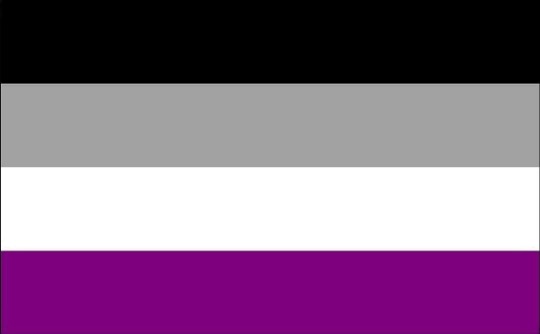
I often think that those on the ace spectrum are amongst the most misunderstood in the LGBTQ+ community. Asexuality is an absence of sexual attraction but that doesn’t necessarily mean an absence of romantic attraction. There are also people who identify as aromantic but who do experience sexual attraction. The ace spectrum has what is known as a ‘gray area’ which includes sub-identities such as demisexuality, a sexual attraction only to people with whom one has an emotional connection. I think that the ace spectrum is one of the clearest indicators that sexual and romantic orientations are completely different things and therefore they don’t actually have to match up within the same person. For a while now, I’ve been considering the fact that my own sexual and romantic orientations do not quite match. I’m pretty sure I’m actually heteromantic bisexual and I honestly only have the relatively recent dismantling and separation of sexual and romantic attraction, largely spearheaded by the exposure and discussion of the ace spectrum, to thank for the realisation of that possibility. Anyways, here are a few books with characters who fall somewhere under the ace umbrella. -Love, Alex x
1. Let’s Talk About Love by Claire Kann.
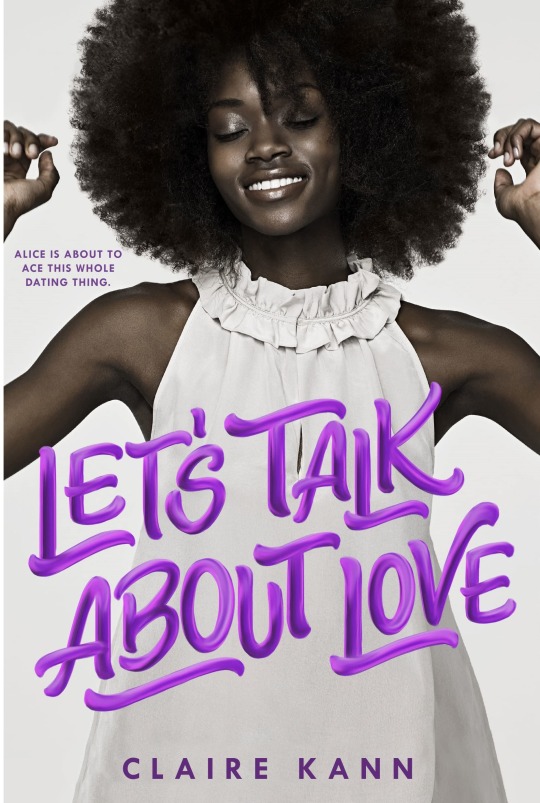
When Alice comes out as asexual, her girlfriend dumps her and she swears off dating for good but then handsome Takumi enters her life and she can’t seem to ignore the rom-com level of feels. It’s funny, cute and so thoroughly readable with a very relatable protagonist, making it a fantastic book for normalising asexuality.
2. Before I Let Go by Marieke Nijkamp.
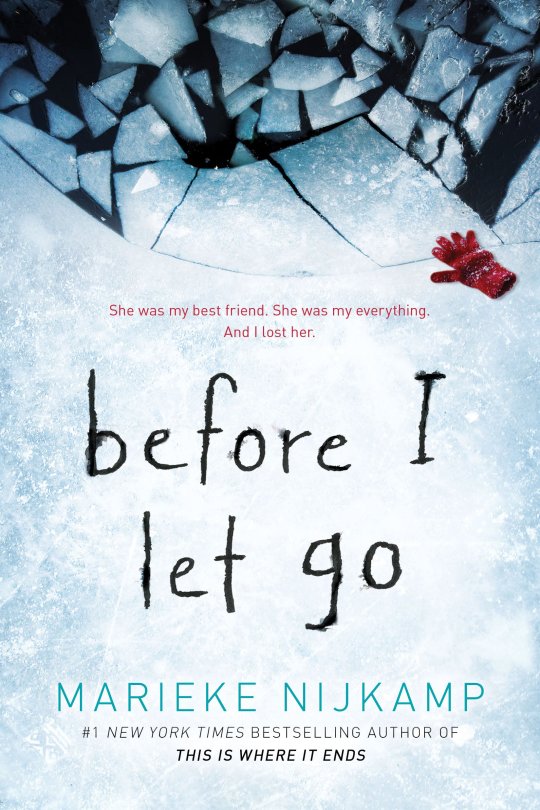
When Corey’s best friend Kyra dies, she realises that their small Alaskan town is behaving very strangely and keeping secrets. I’ll admit that this book doesn’t have particularly high ratings on Goodreads and that’s probably because it promises to be more atmospheric and eerie than it is. However, Corey’s asexuality isn’t a driving factor of the plot -she simply is, which I find wonderfully refreshing. She is also questioning which I think will provide a window for people who are still figuring things out.
3. The Sound of Stars by Alechia Dow.

Ellie and Morris live in a dystopian world, devoid of emotional and creative expression, but they both risk their lives for their love of the forbidden arts. This is a wonderfully unique sci-fi with both main characters displaying demisexuality. It’s definitely one for bookworms and pop culture nerds who would die to protect creativity and emotional freedom.
4. How To Be A Normal Person by T. J. Klune.

Gus is an eccentric soul and he’s fine with not fitting in until he meets asexual bohemian Casey and he vows to become as normal as possible. It’s funny, heartwarming and incredibly queer with an array of fantastic side characters. This is a great book for learning more about the ace spectrum and a lovely positive depiction of a loving, respectful ace relationship.
5. Every Heart A Doorway by Seanan McGuire.
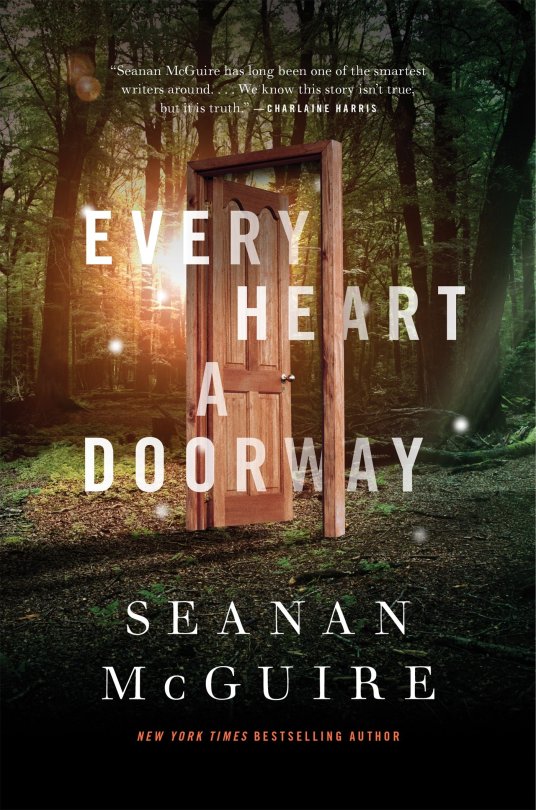
When children return from other worlds, they are forever changed and Eleanor West’s Home for Wayward Children is there for them until they can fall back through their door. These whimsical novellas are brimming with diverse queer characters and this first instalment is narrated by asexual teen Nancy. The clear distinctions between asexuality and aromanticism are talked about but I love how identity and sexuality is never a plot point or defining characteristic in these stories.
6. Upside Down by N. R. Walker.

When recently dumped Hennessey moves to a new town, he sets up a support and social group for LGBT+ people, which is where he meets socially awkward Jordan. There is a lot of asexual education without being too preachy and I learnt so much from this very sugary gay romance. If you like a bit of tension or drama, it’s probably not for you but if you’re looking for an easy, funny, cute read, pick it up!
7. Summer Bird Blue by Akemi Dawn Bowman.
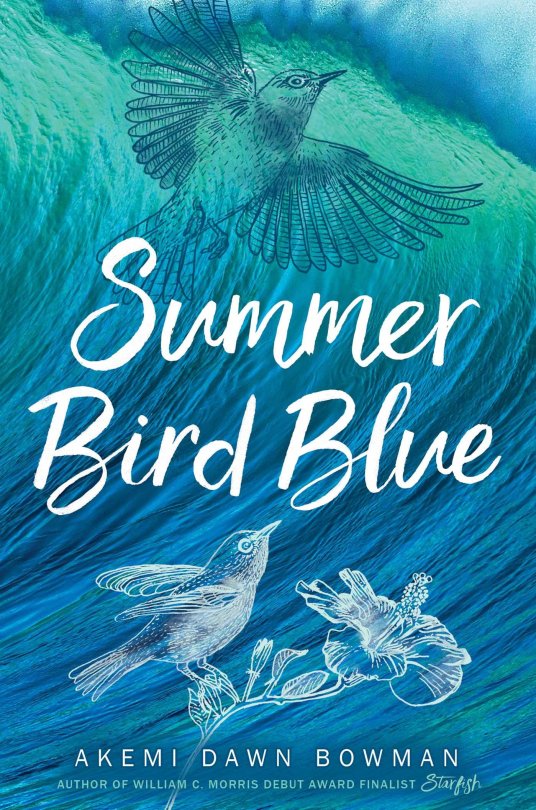
When her sister dies, Rumi is sent to live with her aunt in Hawaii where she makes some unlikely friends and eventually finds the courage to return to the music that she and her sister loved so dearly. Rumi is asexual and aromantic and she’s terrified that she’ll never find anyone who understands her like her sister did. As you might expect, this book is devastating but so beautiful.
8. Loveless by Alice Oseman.
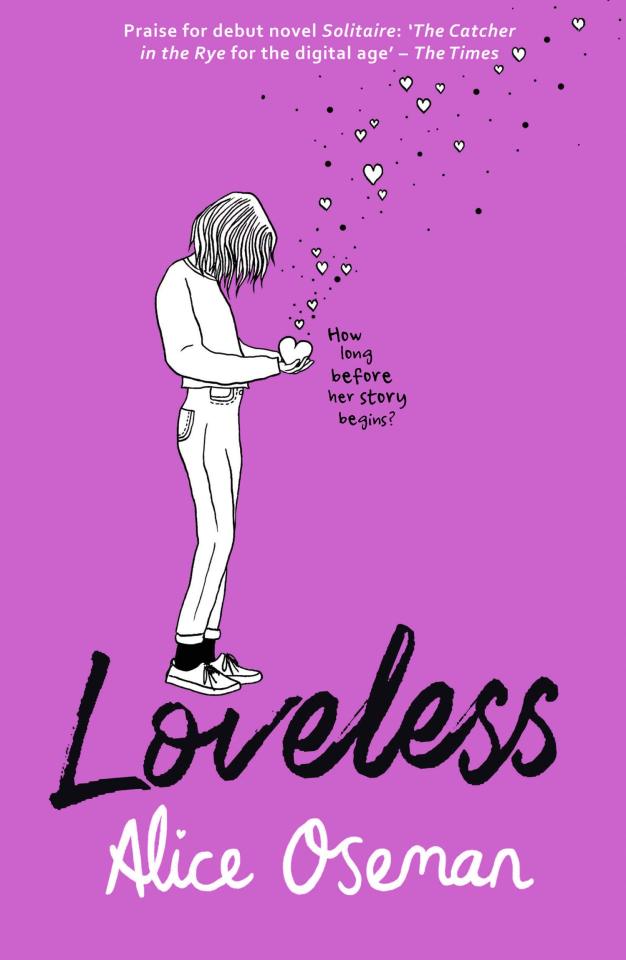
When Georgia starts university, she’s sure that her love life will finally begin but she is about to learn what true love really entails. Loveless isn’t actually released until next month but it’s a HIGHLY anticipated book charting an asexual aromantic’s learning and self-acceptance as well as being a true celebration of platonic love. Pre-order it now!
900 notes
·
View notes
Note
You know what? Thank you for reblogging/adding to that post about the hot mess that is Fusebox's handling of LGBTQ characters/content. At first I chalked it up to them having a small team and wanting to emulate the show (which is so straight it's painful sometimes) as much as possible to better market the game, but we're now almost 4 seasons in and as a queer person I am TIRED. They have an opportunity to make the game better and more inclusive in a way the show will frankly probably never be and they're just...not going to do that because ????? (Money. It's because of money). Yet in every survey they have these questions about diversity/identities/inclusivity we want to see so they can pretend like they're going to include it AND get it right.
And yeah, maybe some of it COULD be interpreted as "things a closeted person would say to deflect suspicion" (looking at you Chelsea, our "unfortunately I am very heterosexual" bra 👀), but the thing with that is it will only ever mean anything like that if they actually...write the narrative to show these characters are actually closeted/working through the process of discovering themselves. Which they won't!!!!! So we're just left here reading things into lines here and there trying to build some queer characterization that makes sense because the writers can't (or won't).
oh my god, THIS! ALL OF THIS!! money will always speak louder, and i'm confused on why they think they would lose players over better queer storylines, so they just give us scrapes and drafts.
because hey, if you think players wouldn't download the game and pay real money for it, the homophobia lies within. you're trying to predict something you're not even sure it's gonna happen.
and i follow fusebox on twitter and instagram, and i can say i've never seen people complaining about queer characters' screentime ????
"write the narrative to show these characters are actually closeted/working through the process of discovering themselves."
if there was any intention of bringing those arc to full circle there would be a finishing touch, some realization, development in interpersonal relationships that involve said sexuality somehow.
BUT NO.
there's never more than just joking around and being awkward about it. either they make girls run like criminals (WEDDING EPISODES HAVE ME IN ANGER SWEATING), or having a small crumb of content, and for what!??!
DON'T GET ME STARTED ON THE BOYS.
i said last year that i hated what they did to tai and ciaran's storyline. it was so poorly handled and legit scary how they thought "yes, this is good. it's fine that we never planted a single seed of affection between them, not even a small sign of flirting or banter" and threw the coupling card around like it was nothing.
after so many players begged, OUT LOUD, for a bisexual male couple, after seeing what it was done i was left in tears, man. they really said "TAKE IT. ISN'T THIS WHAT YOU WANTED? NOW TAKE IT."
if the female characters already get the shorter end, the male ones don't even have an end to grab on!
what's the hold up about bi boys??? is it so hard to find them in the wild to get their perspective? cause i follow a shit ton of them on instagram and tik tok, and the subject about them always ends up being how biphobia hits their love life.
the whole point of including queer characters it's because we want people to realize IT'S NORMAL, and we need representation. just because male players are not the majority here it doesn't mean fusebox shouldn't get it done properly!
it feels like the company needs to open the discussion in their office, because this is painfully straight envisioned. besides, you mentioned the show, and i have to say, being based off it, they have the power to bring awareness so it won't stay a taboo.
saying "i'm not straight" shouldn't cause a wave of horror in people. it only stimulates more ignorance on the matter, and people fear what they don't understand.
not giving proper representation only brings more reasons to people dismiss it like it's nothing, but they forget REAL HUMANS ARE OUT HERE, PLAYING THE GAME, ADVERTISING IT ON SOCIAL MEDIA THROUGH MEMES, HEADCANONS, FANFICTION, BESIDES PAYING REAL MONEY TO CONTRIBUTE TO A GAME THAT BARELY CARES ABOUT THEM.
sexuality is a spectrum, and that's the very basic reason why it needs to be treated more carefully, AND MORE FREQUENTLY.
and thank you for your ask, you just legit said everything and a little more on it!
26 notes
·
View notes